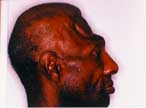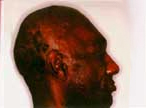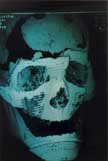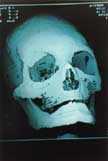
Craniofacial Surgery
What is craniofacial surgery?
Craniofacial surgery is a sub-specialty of oral surgery that focuses on the treatment of patients who have birth defects such as cleft lip and palate. The craniofacial surgeon will work with a team that may include speech pathologists, orthodontists, and craniofacial plastic surgeons in planning treatment to correct cleft lip and palate, as well as other jaw and face abnormalities.
As a member of a craniofacial team, the craniofacial surgeon works to restore the jaw and facial structures, with the goal of restoring normal function and appearance. This includes surgical treatment of the position of the jaws, and pre- and post-operative treatment of jaw surgery.
Cleft Lip
During early pregnancy, separate areas of the face develop individually and then join together, including the left and right sides of the roof of the mouth and lips. However, if some parts do not join properly, sections don’t meet and the result is a cleft palate. If the separation occurs in the upper lip, the child is said to have a cleft lip.
A completely formed lip is important not only for a normal facial appearance but also for sucking and to form certain sounds made during speech. A cleft lip is a condition that creates an opening in the upper lip between the mouth and nose. It looks as though there is a split in the lip. It can range from a slight notch in the colored portion of the lip to complete separation in one or both sides of the lip extending up and into the nose. A cleft on one side is called a unilateral cleft. If a cleft occurs on both sides, it is called a bilateral cleft.
A cleft in the gum may occur in association with a cleft lip. This may range from a small notch in the gum to a complete division of the gum into separate parts. A similar defect in the roof of the mouth is called a cleft palate.
Cleft Palate
The palate is the roof of your mouth. It is made of bone and muscle and is covered by a thin, wet skin that forms the red covering inside the mouth. You can feel your own palate by running your tongue over the top of your mouth. Its purpose is to separate your nose from your mouth. The palate has an extremely important role during speech because when you talk, it prevents air from blowing out of your nose instead of your mouth. The palate is also very important when eating. It prevents food and liquids from going up into the nose.
As in cleft lip, a cleft palate occurs in early pregnancy when separate areas of the face have developed individually do not join together properly. A cleft palate occurs when there is an opening in the roof of the mouth. The back of the palate is called the soft palate and the front is known as the hard palate. A cleft palate can range from just an opening at the back of the soft palate to a nearly complete separation of the roof of the mouth (soft and hard palate).
Sometimes a baby with a cleft palate may have a small chin and a few babies with this combination may have difficulties with breathing easily. This condition may be called Pierre Robin sequence.
Since the lip and palate develop separately, it is possible for a child to be born with a cleft lip, palate or both. Cleft defects occur in about one out of every 800 babies.
Children born with either or both of these conditions usually need the skills of several professionals to manage the problems associated with the defect such as feeding, speech, hearing and psychological development. In most cases, surgery is recommended. When surgery is done by an experienced, qualified oral and maxillofacial surgeons such as our doctors the results can be quite positive.
- Difficulty Eating – When there is a separation or opening in the palate, food and liquids can pass from the mouth back through the nose. While they await surgery, patients can use specially designed prosthetics to help keep fluids flowing downward toward the stomach, which ensures that they receive adequate nutrition.
- Speech Difficulties – Because the upper lip and palate are not properly formed, it may be difficult for children to speak clearly. When they do, a nasal sound may be produced. Their speech may be hard to understand, so a speech pathologist may be consulted to resolve these issues.
- Ear Infections – Cleft lip and palate can lead to a buildup of fluid in the middle ear, which leaves children with a higher risk for ear infections. If it’s not properly treated, even deafness can occur. To prevent infections, small tubes may be placed in the eardrums to facilitate fluid drainage.
- Dental Problems – Children who suffer from cleft lip and palate also often have missing, malformed, or displaced teeth, which causes a higher number of cavities and other dental and orthodontic issues.
Treatment
The treatment for cleft lip and palate is most likely surgery. This is where your craniofacial surgeon and team of specialists come in. Depending on the severity of the case, more than one surgery may be necessary.
In children, surgery for cleft lip usually takes place between three and six months of age. The cleft hard palate is generally repaired between the ages of 8 and 12 when the cuspid teeth begin to develop. The procedure involves placement of bone from the hip into the bony defect, and closure of the communication from the nose to the gum tissue in three layers. It may also be performed in teenagers and adults as an individual procedure or combined with corrective jaw surgery.
The major goals of surgery are to:
- Close the gap or hole between the roof of the mouth and the nose.
- Reconnect the muscles that make the palate work.
- Make the repaired palate long enough so that the palate can perform its function properly.
- There are many different techniques that surgeons will use to accomplish these goals. The choice of techniques may vary between surgeons and should be discussed between the parents and the surgeon prior to the surgery.
Reconstructive Craniofacial Surgery

Patient with severe forehead defect present for
13 years after being struck by a baseball bat.

Patient 6 days after reconstruction of forehead
with titanium mesh and hydroxyapatite.
Being born with a normal-appearing face is something we often take for granted, but for some unfortunate children this is not the case. There are a great variety of craniofacial syndromes and birth defects that can occur ranging from cleft lip and palate to afflictions such as Crouzon’s or Treacher Collins Syndrome. These disfiguring facial birth defects have great effect not only on a child’s appearance but on his or her function, psychological development, and well being.
Early corrective surgery can have a tremendous positive impact on these children. Our doctors are experienced in treating the most severe craniofacial deformities and have been featured on the local, national, and international news for surgery performed on a 5 year old child with craniofacial microsomia utilizing computer-generated stereolithographic models to plan the surgery. Using a computer-generated 3-D model the doctors were able to actually perform the skeletal surgery on the model and shape the titanium bone plates that hold the bones together before even entering the operating room. Dr. Bianchi, Dr. Nordone, Dr. Kanter, Dr. Huffman, Dr. Kern, and Dr. Schlesinger are members of the multidisciplinary cleft palate-craniofacial team at St. Christopher’s Hospital for Children which allows their patients access to a team of the most experienced professionals from various medical and allied health specialties to deal with these complex problems.
Facial Reconstructive Surgery
Either through accident or illness such as benign or malignant facial or jaw tumors, many patients can present with disfiguring and debilitating facial defects. Our doctors have a great deal of experience in facial and jaw reconstructive surgery for patients with these difficult problems. Such post traumatic or post tumor resection deformities often require extensive soft tissue and bone graft reconstruction to replace missing anatomic structures and restore function.

Pre-Operative 3-D CAT scan showing
extent of forehead defect.

Post-operative 3-D CAT scan showing
reconstructed forehead defect.
Oral and Maxillofacial surgeons, such as our doctors offer a unique perspective as they are as much concerned with excellent function as well as the overall aesthetic appearance of the face and jaws of their patients. The doctors are well versed in the latest technology available for facial reconstructive surgery. Such techniques include craniofacial implants which utilizes techniques learned from years of placing dental implants to actually replace missing parts of the facial anatomy (i.e. ears, nose, and eyes).


 Website Powered by Sesame 24-7™
Website Powered by Sesame 24-7™